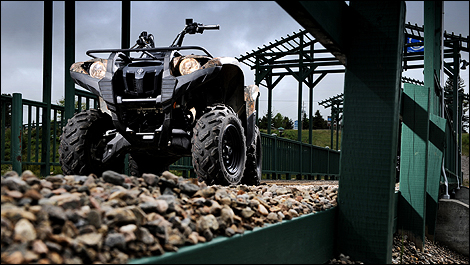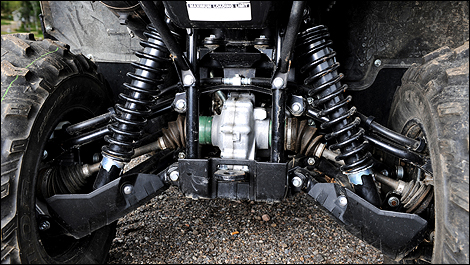ATV manufacturers have been fighting a displacement war for the last 13 years, as it seems they all want to build the biggest, most powerful engine. Nowadays, it’s not unusual to see a 650-, 750-, 800- or even 1,000-cc ATV in regulated trail networks across the country. While it’s true that Yamaha launched hostilities in 1997 with the Grizzly 600, they have now refocused on overall efficiency rather than engine displacement.
 |
| The 2009 Yamaha Grizzly 700 FI EPS Ducks Unlimited has all the feature that fishing, hunting and outdoor enthusiasts look for in an ATV. |
The new
2009 Yamaha Grizzly 700 FI EPS boasts a distinctive look with aggressively-shaped headlights, a prominent bumper and stylish, black-painted aluminum wheels. The unique camouflage treatment of the Ducks Unlimited edition is more resistant to scratches than a conventional plastic cladding, while the generously-sized mud guards offer excellent protection to the rider and passenger, particularly around the legs and feet.
Electric power steering
The riding position of the Grizzly 700 feels natural and totally strain-free, while the wide air-cushion seat is a huge plus in terms of comfort. The high-mounted handlebars keep the rider’s back upright, making the experience even more enjoyable and relaxing, while the low-mounted instruments have been lowered to improve visibility.
Like its smaller 550-cc sibling, the Grizzly 700 FI usesYamaha’s computer-controlled Electric Power Steering (EPS), with variable assist based on speed- and the intensity of any bumps or hits absorbed by the front wheels. I found this generation of EPS technology particularly satisfying on rough trails, as it helps isolate the rider from external forces acting on the front wheels, reduces steering effort in most situations and allows for a tighter turning radius.
Agile and comfortable, but not as sporty
While they did not completely redesign the chassis for the latest generation, Yamaha engineers have significantly improved the rear suspension, especially the A-arms and mounting points. The shorter (And thus overworked) shocks on earlier generations were attached to the upper A-arm and heated up quickly, then lost some effectiveness. Since 2007, longer shocks are now fixed to the lower A-arms, for superior damping and, more importantly, greater longevity.
 |
| Yamaha have significantly improved the rear suspension, especially the A-arms and mounting points. |

